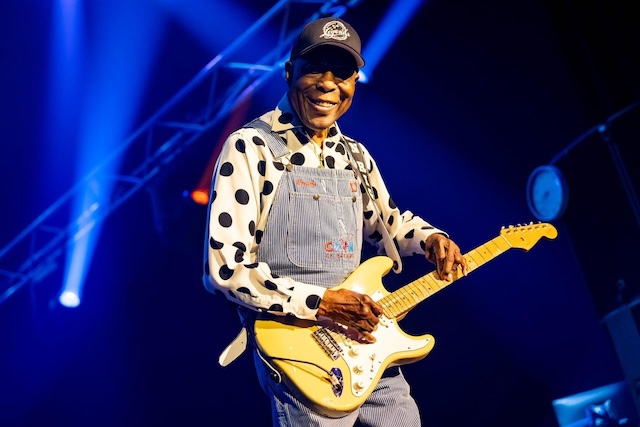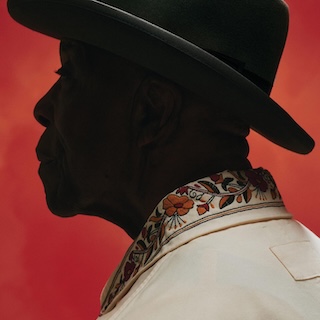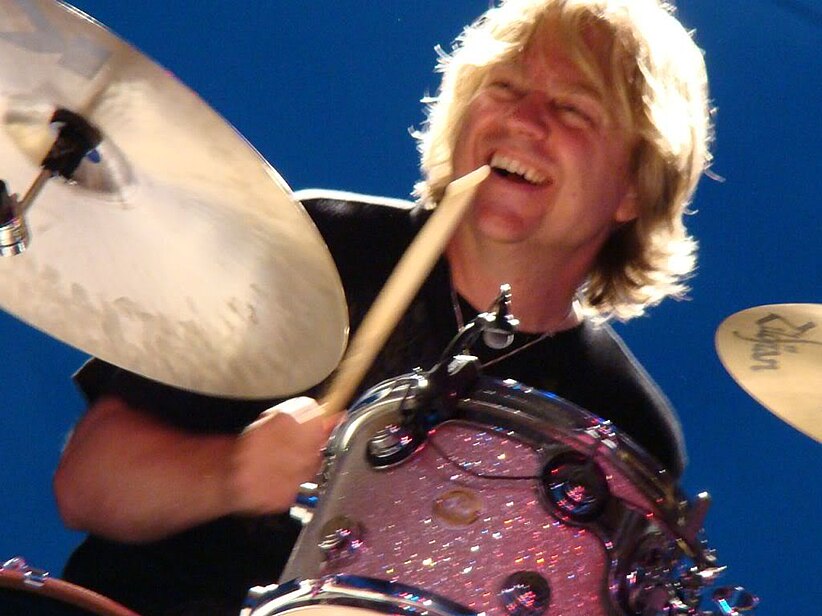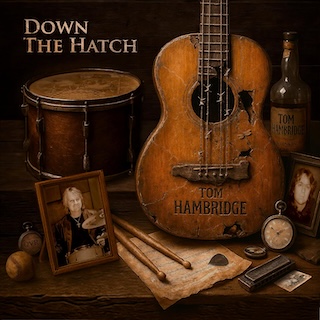
Buddy Guy at 89: Playing with purpose and passion, singing with wisdom and feeling, and plumbing his biography for seasoned perspectives on his life, loves and travels
By David McGee
 AIN’T DONE WITH THE BLUES
AIN’T DONE WITH THE BLUES
Buddy Guy
RCA/Silvertone Records
On his first album since 2022’s The Blues Don’t Lie, 89-year-old Buddy Guy sounds revitalized even beyond his 2022 performances. Playing with purpose and passion, singing with wisdom and feeling, plumbing his biography for seasoned perspectives on his life, loves and travels, he rises above time over 18 cuts, with typically impeccable guidance from producer Tom Hambridge (whose new solo album, Down The Hatch, is reviewed below), the backing of musicians with impeccable resumes (including Chuck Leavell (Wurlizter-B3-piano), Tal Wilkenfeld and Glen Worf (electric and upright bass), Kevin McKendree (B3-piano), Nike Rojas (B3-keys), Max Abrams (saxophone), Steve Patrick (trumpet-flugelhorn), Michael Hicks (background vocals), and Hambridge (on drums). As was the case on The Blues Don’t Lie, a few guest artists are on board to add their special heat to the festivities. These guests, though, are better suited, being steeped in blues and gospel as they are, to spice up Buddy’s musings than those in the 2022 lineup: Joe Bonamassa, Joe Walsh, Peter Frampton (anyone remember the Frampton of Humble Pie and Frampton’s Camel?), and Blind Boys of Alabama add emotional but breviloquent excerpts of their signature sounds while staying out of Buddy’s way; strikingly, the formidable young traditionalist Christone “Kingfish” Ingram (whose Live in London album was #2 on the Deep Roots Elite Half-Hundred, 2023) further burnishes his growing legend by contributing piercing upper neck commentary to buttress the pumping horns, frisky New Orleans-style piano soloing and stomping, funky beat (plus some interstellar electronic effects) of Hambridge’s “Where U At” (note its lyrical references to Congo Square, Tipitina’s, and other New Orleans landmarks). A couple of the many remarkable facts about the aptly titled Ain’t Done With The Blues are the force of Buddy’s overpowering performances from beginning to end, and the candor and courage he brings to the more painful and personal reflections here. Buddy Guy will not be silenced.

‘Hooker Thing,’ Buddy Guy’s homage to John Lee Hooker, from Ain’t Done With The Blues
There are touches of the Buddy rarely seen, namely the expressive acoustic guitarist who leads off the album with a 1:08 excursion into “Hooker Thing,” an homage to one of his foundational influences, John Lee Hooker, featuring just Buddy, his lowdown acoustic and his subtly understated reading of a snippet of “Boogie Chillun,” of which we hear Buddy say, softly, “It’s the first thing I learned to play.” Later he takes up the acoustic again and announces, “I could give you a little Lightnin’ if you want it,” and over the next 1:10 sings an earthy “I got a gypsy woman givin’ me good advice/I got a whole lotta tricks restin’ here on ice…” followed by a short, sharp run of single notes on the treble strings preceding a spoken postscript: “Love Lightnin’ Hopkins.”

‘Where U At,’ Buddy Guy with Christone ‘Kingfish’ Ingram, from Ain’t Done With The Blues
Which is also to say the past is ever-present in these songs, some penned by Buddy, some by Tom Hambridge, along with covers of chestnuts by J.B Lenoir, Earl King, and the John Marascalco-Leo Price blues ballad made immortal by Little Richard, “Send Me Some Loving,” on which Buddy beautifully pleads his case in his most heartfelt wounded vocal and complements his woeful plight with guitar voicings that rise from spare and stinging to richly textured fills. But it’s in the philosophical, autobiographical originals where things really get interesting. “I have a lot of stories I’d like to tell/I’ve been everywhere, done everything,” says Buddy in introducing in the grinding “Been There Done That,” a personal Baedeker of his path from the cottonfields to playing before royalty and every place in between (“I’ve seen them come and go…”), with a hearty assist from Leavell’s righteous organ support preceding a searing Strat solo, one of many of Buddy’s blistering punctions herein. The song has a poignant tint as well, given Buddy’s announcement of his touring days coming to an end. Hard on the heels of this comes “The Blues Chase the Blues Away,” one of the philosophical treatises explaining exactly what the title states: the ability of blues music, in the toughest times, after the hardest of days, to lift the spirits, a message given added emphasis by McKendree’s freewheeling piano and the double guitar attack by Buddy and Rob McNelley, along with striking lyrical references to the uplifting components of B.B. King’s and Little Walter’s music. A similar theme animates “It Keeps Me Young,” a bouncy ode to the music’s restorative powers, as Buddy notes: “Chicago blues, I like it loud/I turn it up, never turn it down/it keeps me young/man, I’m having fun/it makes feel like I did when I was 21.” At which point Frampton enters with a swaggering vocal extolling the pleasures his woman returns to him when “I give her my respect” and she in turns “makes me feel like I did when I’m 21,” and then adds a lyrical, swinging guitar solo to underscore his satisfaction.

‘Blues Chase the Blues Away,’ Buddy Guy, from Ain’t Done With The Blues
Amidst all this frolic Buddy dips into chilling social commentary on “I Don’t Forget,” a simmering, ominous slow blues with an ethereal opening wash of subdued electronic drones as Buddy enters, singing, “Call me a fool, I’ve been called worse/Buddy Guy remembers the pain that always hurts/you can tell me slaving days are gone/but it don’t eras years and years of wrong/I don’t forget my deepest history/I still got scars across my memory/I don’t forget the things I’ve seen…” He goes on to recall the privations and denigrations of the Jim Crow era, as McNelley’s searing slide guitar underscores the caustic reflections with piercing commentary. Given the temper of the times, given the current administration’s attempts to, shall we say, whitewash American history at the Smithsonian and elsewhere, Buddy’s performance is downright courageous. The soul cleanser here actually precedes “I Don’t Forget” in the album sequence, when the Blind Boys of Alabama join Buddy for a hallelujah workout on a redemption song, “Jesus Loves the Sinner,” with the guitar howling deep and gnarly over driving percussion, as the Blind Boys shadow Buddy’s preacherly text and take a verse themselves after Buddy sets the stage with “There’s so much temptation in the world today/the Devil wants your soul in the very worst way/so if you get caught in Satan’s book, read what’s down in Gideon’s book/Jesus loves the sinner but he hates the sing/He’ll lead you out of danger if you’ll trust in him/He’ll change a born loser into a born-again winner…” The Blind Boys enter in full-on gospel fury, the guitar issues a stinging cry, and the whole endeavor rushes to a house wrecking close in which guitar, percussion and voices engage in a powerhouse call-and-response finale. At which point the thin line between gospel and blues disappears.

‘Jesus Loves the Sinner,’ Buddy Guy with the Blind Boys of Alabama, from Ain’t Done With The Blues

‘Dry Stick,’ Buddy Guy with Joe Bonamassa, from Ain’t Done With The Blues
Bonamassa offers atmospheric six-string support to lend a plaintive edge to Buddy’s “Dry Stick,” a gospel-tinged ballad based on his mother’s advice to “keep some dry wood around/save a dry stick for a wet day/you’ll never know what’s coming your way/rain or shine, who can say/save a dry stick for a rainy day,” a touching, introspective remembrance made all the more affecting for its common sense philosophizing and spiritual overtones (the gospel background voices certainly sound like the Blind Boys, who are not indicated as being on the track). Joe Walsh shows up vocally and on slide guitar in a duet with Buddy on “How Blues Is That,” a hard-edged recollection of Buddy’s early struggling days in Chicago (“…had a lot of doors slammed in my face/sang on the corner, poured out my heart/picked up my change, slept out in the park/how blues is that?”), Walsh sounds hungry here, belting out his down-and-out woes in a fiery slide-supported vocal reminiscent of his James Gang days.

‘I Don’t Forget,’ Buddy Guy, from Ain’t Done With The Blues: ‘You can tell me slaving days are gone/but it don’t erase years and years of wrong…’
If indeed we’ve seen the last of Buddy on stage, then we can take comfort in the strength of his studio performances, all of which underscore the truth of his new long-player’s title. On this, the smartest, deepest blues album of the year, the execution—lyrically, vocally, musically, conceptually—is flawless. In other words, the blues ain’t done with Buddy Guy yet either. And Buddy Guy will not be silenced.
***

Tom Hambridge: Following Buddy Guy’s example of aging gracefully….
The Juggernaut Rolls On
By David McGee
 DOWN THE HATCH
DOWN THE HATCH
Tom Hambridge
Quarto Valley Records
To blues and blues-rock fans, Tom Hambridge is likely best known as a producer with a staggering resume over the past quarter century: some 100 albums bear his producer credit, with multiple Grammy winners and multiple Grammy nominations among them. Most recently, he’s racked up Grammy wins and Grammy nominations for producing, playing, and singing on albums by Buddy Guy, Keb’ Mo’, Taj Mahal, and all of Christone “Kingfish” Ingram’s studio efforts (662 being a Grammy winner) and his 2023 Live in London, which means Hambridge has essentially guided the young blues phenom into the blues hierarchy. Anyone familiar with his productions also knows he’s a prolific songwriter, a solid drummer, and an earthy vocalist. The list of albums to which he has contributed as a producer, songwriter, musician, even a liner notes writer is fairly mind-boggling (check his Wikipedia entry here). Somehow, beginning in 1996, he’s managed to carve out an impressive career as a solo artist and band leader. His solo efforts have much to recommend them, but as he approaches his 65th birthday (December 20), Hambridge is following his friend Buddy Guy’s example of aging gracefully. Arguably, his 2023 album, Blu Ja Vu (#41 on the Deep Roots Elite Half-Hundred, 2023), showcased his finest solo work to that point, only to be superseded by his new solo effort (his ninth such effort), Down the Hatch. The one-man musical juggernaut rolls on.

‘Willie Dixon’s Gone,’ Tom Hambridge, from Down The Hatch

‘Every Time I Sing the Blues,’ Tom Hambridge, from Down the Hatch
As for support, Hambridge leads a familiar team: Rob McNelley (guitar), Kevin McKendree (piano), Tommy MacDonald (bass), Glen Worf (upright bass),supplemented by guitarists Bob Britt (of Bob Dylan’s band) and Tom Bukovac, with Noah Forbes, Jimmy Wallace, Mike Rojas, and John Lancaster on keys, plus a guy named Buddy Guy adding spitfire guitar and variations on a familiar riff in a sizzling rock ‘n’ roll tribute to Chuck Berry (Hambridge once played drums with Berry) on “You Gotta Go Through St. Louis,” which also happens to feature a rollicking McKendree piano solo (itself an homage to Chuck’s legendary master of the 88s, Johnnie Johnson). Most of the dozen songs are Hambridge-Richard Fleming collaborations (save for a vintage co-write with Gary Nicholson and a 2011 collaboration with Fleming and George Thorogood), plus one Hambridge solo copyright, “Making Lemonade,” a barnburner about making the most out of bad situations defined by Hambridge’s driving percussion, Bukovac’s merciless guitar attack and spirited accordion atmospherics provided by Smashing Pumpkin Tim Lauer.

‘What Might Have Been,’ Tom Hambridge, from Down The Hatch
Among the low-key moments, a Hambridge-Gary Nicholson co-write, “Every Time I Sing the Blues,” offers a searing slow blues litany of woes bedeviling the singer (“ I might think about a woman who done me wrong/I might think about some hard times where I was barely hanging on/I might think about a brother who still can’t make ends meet/or some fallin’ sisters selling it out on the street/I’m just tryin’ to tell the truth every time I sing the blues/I find my inspiration in tears and desperation…”), capped by McNelley’s anguished guitar retort. Buddy Guy introduced this song on his 2008 album, Skin Deep (not a Hambridge production) and featured Eric Clapton soloing on the track. Another slow blues boiler, “Hard Times,” with Hambridge on drums providing the heartbeat bottom, captures the current zeitgeist in capsule form (“Prices going up down at the Dollar Store/Things we used to buy we can’t afford no more/hard times…”) and adds a warning to generations coming of age: “Children of the future/better find a better way/doomsday’s around the corner/there’ll be some hell to pay…hard times…” Hambridge delivers these and other dark musings in a world-weary voice, with nuanced phrasing evoking and heightening the dramatic effect—at his best Hambridge summons the spirit of Gregg Allman at his most penetrating.

‘Hard Times,’ Tom Hambridge, from Down The Hatch
Not that Hambridge loses any glide in his stride when he kicks out the jams. With “Willie Dixon’s Gone” the album roars out of the gate at a brisk gallop fueled by guitar and drums with a rousing vocal to boost this red-hot recollection of the good old days, even as he laments the present state of affairs in the aftermath of the great blues songwriter’s departure from this mortal coil. “Good times ain’t as good as they used to be/I don’t feel as cool in a cool, cool breeze/women ain’t as willin’, whiskey ain’t as strong/the blues ain’t as blue since Willie Dixon’s gone..,” This powerhouse attack was a Hambridge-Fleming co-write with George Thorogood for the latter’s 2011 album, 2120 South Michigan Ave. In a fine performance, Thorogood met the demands of the song’s urgency, but the electrifying blend of Hambridge’s freewheeling vocal and McNelley’s relentless guitar compares favorably to Thorogood’s intense reading. Elsewhere, wise decisions, exemplary songwriting, emotionally resonant lyric readings, and inspired arrangements are perfectly executed in elevating the singer’s despair in the simmering blues of “What Might Have Been”; in the lubricious stomp and apocalyptic desire (cleverly expressed in passages such as “lawyer wants a case/I want to get with you like a birthday wants a cake..”) animating “I Want You Bad”; and in “Start Drinking Early Day,” a witty catalogue of woes cured by taking solace in alcoholic beverages pre-emptively, before the blues pile up and pile on (actually, Rodney Dangerfield had a priceless bit about this very subject) with Hambridge’s sang-froid in accepting his liquid destiny enhanced, or made to seem inevitable, by McNelley’s upbeat syncopated electric picking.
Willie Dixon is indeed gone, but his aphorism, “The blues is about life. If it ain’t about life, it ain’t the blues,” is affirmed and reaffirmed many times over in this heady mix. Roll on, Tom. Roll on.

